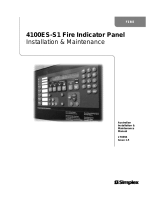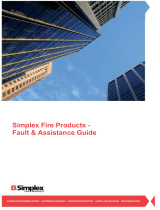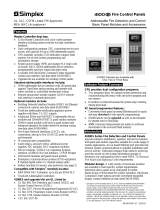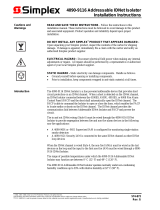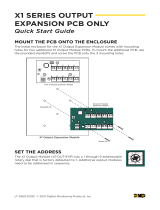Page is loading ...

Fire
Australian
Installation
Manual
4100 ES Fire Indicator Panel
Installation & Maintenance
Australian
Installation &
Maintenance
Manual
LT0350
Iss 1.5

iii
2006, 2013 Tyco Australia Pty Limited. All Rights Reserved.
All specifications and other information shown were current as of document revision date,
and are subject to change without notice.
Tyco, Simplex, the Simplex logo, MAPNET II, IDNet, TrueAlarm, SmartSync,
WALKTEST, MINIPLEX, and TrueAlert are trademarks of Tyco International Services
AG or its affiliates in the U.S. and/or other countries. VESDA is a trademark of Xtralis.
Simplex fire alarm technology is protected by the following U.S. Patent Numbers:
TrueAlarm analog smoke detection: 5,155,468; 5,173,683 and 5,543,777. IDNet and
MAPNET II addressable communications; 4,796,025. TrueAlert addressable notification;
6,313,744 and 6,426,697. SmartSync horn/strobe control; 6,281,789.
Australian Standard AS 4428.1
ActivFire Listing Number afp1682
The 4100ES is a Fire Indicator Panel manufactured for Tyco Fire Protection Products:
Tyco Fire Protection Products
47 Gilby Road
Mt Waverley
VIC 3149
AUSTRALIA
Phone : 1300 725 688
Fax : 1300 720 733
Name
Serial #
Manufacture Date
Copyrights and Trademarks
Approvals
Manufacture
Product / Site

iv
Tyco (THE COMPANY) and the User of this/these document(s) desire to share
proprietary technical information concerning electronic systems.
For this reason the company is disclosing to the User information in the form of this/these
document(s). In as much as the company considers this information to be proprietary and
desires that it be maintained in confidence, it is hereby agreed by the User that such
information shall be maintained in confidence by the User for a period of TEN YEARS
after the issue date and only be used for the purpose for which it was supplied.
During this period, the User shall not divulge such information to any third party without
the prior written consent of the company and shall take reasonable efforts to prevent any
unauthorised disclosure by its employees. However, the User shall not be required to
keep such information in confidence if it was in their possession prior to its receipt from
the company; if it is or becomes public knowledge without the fault of the User; or the
information becomes available on an unrestricted basis from a third party having a legal
right to disclose such information.
The User's receipt and retention of this information constitutes acceptance of these terms.
This information is copyright and shall not be reproduced in any form whatsoever.
The 4100ES Fire Alarm System provides a configuration programming facility, which
may be accessed via a programming computer using a “dongle”. Because this
programming facility allows the user to define in detail the operation of the 4100ES
System being customised, changes may be made by the user that prevent this installation
from meeting statutory requirements.
The Company, therefore cannot accept any responsibility as to the suitability of the
functions generated by the user using this programming facility.
Non-Disclosure Agreement
End User Liability Disclaimer

v
This manual applies to product with the following:
Model number : 4100ES
Firmware revision : 1.02.04 and on
Document Name : LT0350 4100ES Installation & Maintenance Manual
Issue : 1.5 25 Feb, 2015
14 May, 2004 Issue 1.0.6 Original based on 574-848 Rev G
16 June, 2005 Issue 1.0.7 Added Tyco 614 detectors to Appendix F
30 Oct, 2005 Issue 1.0.8 Added System Sensor detector 885WP-B to List of
Approved Devices in Appendix F.
6 October
2006
Issue 1.0.9 References to LT0432 and 1976-181 Wiring Diagrams
added.
30 Nov. 2006 Issue 1.0.10 Updated drawings 1976-181 Sheets 102, 203, 500.
23 Jan. 2007 Issue 1.0.11 Clarification to RUI cabling limits (Chapter 3),
Checking wiring (Appendix C), T-GEN connection.
9 Aug. 2012 Issue 1.2 Changes for 4100ES introduction.
3-Oct-13 Issue 1.3 Changes for InfoAlarm display introduction
29-Jan-15
25-Feb-15
Issue 1.4
Issue 1.5
Battery charger adjustment updated.
Updated drawing 1976-174 sheet 1.
Model Number & Firmware Revision
Document
Amendment Log

vi
READ AND SAVE THESE INSTRUCTIONS. Follow the instructions in this
installation manual. These instructions must be followed to avoid damage to this product
and associated equipment. Product operation and reliability depends upon proper
installation.
DO NOT INSTALL ANY SIMPLEX
®
PRODUCT THAT APPEARS DAMAGED.
Upon unpacking your Simplex product, inspect the contents of the carton for shipping
damage. If damage is apparent, immediately file a claim with the carrier and notify your
Simplex product supplier.
SAFETY HAZARD - The 4100ES CPU Card includes a lithium battery. There is
danger of explosion if the battery is incorrectly replaced. Replace only with the same
or equivalent type recommended by the manufacturer. Dispose of used batteries
according to the manufacturer’s instructions.
ELECTRICAL HAZARD - Disconnect electrical field power when making any internal
adjustments or repairs. All repairs should be performed by a representative or authorized
agent of your local Simplex product supplier.
STATIC HAZARD - Static electricity can damage components. Therefore, handle as
follows:
Ground yourself before opening or installing components (use the 553-484 Static
Control Kit).
Prior to installation, keep components wrapped in anti-static material at all times.
EYE SAFETY HAZARD - Under certain fibreoptic application conditions, the optical
output of this device may exceed eye safety limits. Do not use magnification (such as a
microscope or other focusing equipment) when viewing the output of this device.
RADIO FREQUENCY ENERGY - This equipment generates, uses, and can radiate
radio frequency energy and if not installed and used in accordance with the instruction
manual, may cause interference to radio communications. It has been tested and found to
comply with the limits defined in AS 4428.0-1997 and Amendment 1 : 2002.
CLASS A PRODUCT – In a domestic environment this product may cause radio
interference. In which case the user may be required to take adequate measures.
SYSTEM REACCEPTANCE TEST AFTER SOFTWARE CHANGES - To ensure
proper system operation, this product must be tested in accordance with AS 1670 after
any programming operation or change in site-specific software. Reacceptance testing is
required after any change, addition or deletion of system components, or after any
modification, repair or adjustment to system hardware or wiring.
All components, circuits, system operations, or software functions, known to be affected
by a change must be 100% tested. In addition, to ensure that other operations are not
inadvertently affected, at least 10% of initiating devices that are not directly affected by
the change, up to a maximum of 50 devices, should also be tested and proper system
operation verified.
IMPORTANT: Verify 4100ES System Programmer, Executive, and Slave Software
compatibility when installing or replacing system components. Refer to Solution Bulletin
SB11002 for compatibility information.
Cautions, Warnings, and Regulatory Information

vii
Copyrights and Trademarks ......................................................................................... iii
Approvals ..................................................................................................................... iii
Manufacture .................................................................................................................. iii
Product / Site ................................................................................................................ iii
Non-Disclosure Agreement ........................................................................................... iv
End User Liability Disclaimer ........................................................................................ iv
Model Number & Firmware Revision ............................................................................. v
Document ...................................................................................................................... v
Amendment Log ............................................................................................................ v
Cautions, Warnings, and Regulatory Information .......................................................... vi
Table of Contents ........................................................................................................ vii
List of Figures .............................................................................................................. xv
List of Tables .............................................................................................................. xvi
Chapter 1 Introduction to the 4100ES Fire Alarm System .............. 1
Introduction ............................................................................................................... 1
In this Chapter .......................................................................................................... 1
System Configurations .................................................................................................. 1
Overview ................................ ....................... .................. ....................... ................... 1
Standalone Configuration ............................................................................................. 2
Overview ................................ ....................... .................. ....................... ................... 2
System Design .......................................................................................................... 2
MINIPLEX/RTU Configuration ...................................................................................... 3
Overview ................................ ....................... .................. ....................... ................... 3
System Design .......................................................................................................... 3
RUI Communication .................................................................................................. 4
Network Configuration .................................................................................................. 5
Overview ................................ ....................... .................. ....................... ................... 5
Hub and Star Configurations ..................................................................................... 5
Connecting Loops ..................................................................................................... 6
System Design .......................................................................................................... 6
Network Communication ........................................................................................... 6
Glossary ....................................................................................................................... 7
Chapter 2 Installing 4100ES FIP Components ................................. 2-1
Introduction ............................................................................................................ 2-1
In this Chapter ....................................................................................................... 2-1
Introduction to FIPs (4100ES).................................................................................... 2-2
Overview ................................ ....................... .................. ....................... ................ 2-2
CPU Bay ................................................................................................................ 2-2
Table of Contents{ XE "Table of Contents" }

viii
Master Motherboard .............................................................................................. 2-3
CPU Card .............................................................................................................. 2-4
Additional Modules ................................................................................................ 2-4
CPU Card LEDs ..................................................................................................... 2-5
Operator Interface .................................................................................................. 2-6
System Power Supply (SPS) ................................................................................. 2-7
System Power ........................................................................................................ 2-8
The Power Distribution Interface (PDI) .................................................................. 2-8
Step 1. Mounting Cabinets (4100ES) ........................................................................ 2-9
Overview ................................ ....................... .................. ....................... ................ 2-9
Step 2. Mounting Card Bays to Cabinets (4100ES) ................................................... 2-9
Overview ................................ ....................... .................. ....................... ................ 2-9
Front Mounting Bays .............................................................................................. 2-9
Rear Mounting Bays ............................................................................................ 2-10
Step 3. Configuring Cards (4100ES) ....................................................................... 2-11
Overview ................................ ....................... .................. ....................... .............. 2-11
Master Motherboard Configuration ...................................................................... 2-11
CPU Card Configuration ...................................................................................... 2-11
SPS Configuration ............................................................................................... 2-11
PDI Configuration ................................................................................................ 2-12
Configuring Other Cards ...................................................................................... 2-12
Step 4. Interconnecting Modules and Bays .............................................................. 2-12
Overview ................................ ....................... .................. ....................... .............. 2-12
Guidelines .............................. ........................... ................................ ................... 2-12
Card Interconnections in the CPU Bay ................................................................ 2-13
Card Interconnections Within Expansion Bays .................................................... 2-13
Basic Bay-To-Bay Interconnections ..................................................................... 2-13
Connecting to Motherboards ................................................................................ 2-14
Step 5. Installing Modules into Expansion Bays (4100ES) ....................................... 2-16
Overview ................................ ....................... .................. ....................... .............. 2-16
Placement Guidelines .......................................................................................... 2-16
Installing 4” X 5” Cards ........................................................................................ 2-19
Step 6. Installing LED/Switch Modules into Expansion Bays (4100ES) ................... 2-21
Overview ................................ ....................... .................. ....................... .............. 2-21
The LED/Switch User Interface ............................................................................ 2-21
LED/Switch Controller Card ................................................................................. 2-21
LED/Switch Modules ............................................................................................ 2-22
Configuring the LED/Switch Controller Card ........................................................ 2-22
Activating the Communication Loss Feature ........................................................ 2-22
Mounting LED/Switch Modules to the Expansion Bay .......................................... 2-23
Mounting the Controller Card Assembly............................................................... 2-24
Changing Display Card LEDs .............................................................................. 2-24
Interconnecting Cards .......................................................................................... 2-25
Wiring Instructions ............................................................................................... 2-26
Chapter 3 Installing 4100ES MINIPLEX/RTU Components ............. 3-1
Introduction ............................................................................................................ 3-1
In this Chapter ....................................................................................................... 3-1
Introduction to MINIPLEX Transponders (4100ES) ................................................... 3-2
Overview ................................ ....................... .................. ....................... ................ 3-2
Transponder Cabinets ........................................................................................... 3-2
Transponder Interface Cards (TICs) ...................................................................... 3-2
Basic TIC ............................................................................................................... 3-2
Card Specifications ................................................................................................ 3-3

ix
MINIPLEX System Guidelines (4100ES) ................................................................... 3-4
Overview ................................ ....................... .................. ....................... ................ 3-4
Guidelines .............................. ................................ ........................... ..................... 3-4
Configuring Cards (4100ES) ...................................................................................... 3-5
Overview ................................ ....................... .................. ....................... ................ 3-5
CPU Motherboard DIP Switch ............................................................................... 3-5
TIC Configuration ................................................................................................... 3-5
Configuring Other Cards ........................................................................................ 3-5
TIC/Riser Mounting (4100ES) .................................................................................... 3-6
Overview ................................ ....................... .................. ....................... ................ 3-6
Mounting Instructions ............................................................................................. 3-6
TIC/Motherboard Interconnections (4100ES) ............................................................ 3-7
RUI Wiring (4100ES) ................................................................................................. 3-8
Overview ................................ ....................... .................. ....................... ................ 3-8
Wiring Configurations............................................................................................. 3-8
Figure 3-4 The Ferrite Bead .................................................................................. 3-8
Chapter 4 Networking ......................................................................... 4-1
Introduction ............................................................................................................ 4-1
In this Chapter ....................................................................................................... 4-1
Getting Started .......................................................................................................... 4-2
Overview ................................ ....................... .................. ....................... ................ 4-2
Introduction to the 4100 Network Interface Card (NIC) .............................................. 4-2
Overview ................................ ....................... .................. ....................... ................ 4-2
Network Interface Card .......................................................................................... 4-3
NIC Card LED Indications ...................................................................................... 4-3
NIC Media Cards ................................................................................................... 4-4
Requirements and Limitations ............................................................................... 4-5
Step 1. Configuring Network Cards ........................................................................... 4-5
Motherboard Jumper Settings ............................................................................... 4-5
NIC Card Address Setting ..................................................................................... 4-5
NIC Card Jumper Settings .................................................................................... 4-6
Wired Media Card Jumper Settings ...................................................................... 4-6
Step 2. Mounting Media Cards to the NIC ................................................................. 4-7
Overview ................................ ....................... .................. ....................... ................ 4-7
Media Card Mounting ............................................................................................ 4-7
Step 3. Mounting Network Cards ............................................................................... 4-8
Step 4. Wiring Network Cards.................................................................................... 4-9
Overview ................................ ....................... .................. ....................... ................ 4-9
Wiring Guidelines ................................................................................................... 4-9
Wiring Distances .................................................................................................. 4-10
Related Documentation ....................................................................................... 4-10
Fiber-Optic Wiring ................................................................................................ 4-11
Fiber Optic Connection Types ............................................................................. 4-11
4190-9010 Coupler Requirements ....................................................................... 4-12
Wiring with the Wired Media Card ........................................................................ 4-13
Loop Wiring, mixed Fibre and Cable .................................................................... 4-15
Chapter 5 The System Power Supply & Alarm Relay Card ............ 5-1
Introduction ............................................................................................................ 5-1

x
In this Chapter ....................................................................................................... 5-1
SPS Specifications .................................................................................................... 5-2
Input/Output/BatterySpecifications ......................................................................... 5-2
SPS Current Consumption ..................................................................................... 5-3
Environmental Requirements ................................................................................. 5-4
SPS Configuration ..................................................................................................... 5-4
Overview ................................ ....................... .................. ....................... ................ 5-4
Jumper Settings ..................................................................................................... 5-4
Setting the Device Address .................................................................................... 5-4
Adjusting Voltages ................................................................................................. 5-4
SPS LED Indications ................................................................................................. 5-5
LEDs ........................................... ........................................................................... 5-5
Troubleshooting an SPS ............................................................................................ 5-6
Overview ................................ ....................... .................. ....................... ................ 5-6
IDNet Power Monitor Trouble................................................................................ 5-6
Extra Device .......................................................................................................... 5-6
Class A Trouble ..................................................................................................... 5-6
Earth Fault Search ................................................................................................. 5-6
Short Circuit ........................................................................................................... 5-6
Channel Fail .......................................................................................................... 5-6
No Answer/ Bad Answer ........................................................................................ 5-6
Output Abnormal .................................................................................................... 5-6
The Alarm Relay Card ............................................................................................... 5-7
Overview ................................ ....................... .................. ....................... ................ 5-7
Mounting ................................................................................................................ 5-7
Configuration ......................................................................................................... 5-8
Notes ..................................................................................................................... 5-8
Warning ................................................................................................................. 5-8
Specification .......................................................................................................... 5-8
Chapter 6 SPS Field Wiring (4100ES) ............................................... 6-1
Introduction ............................................................................................................ 6-1
In this Chapter ....................................................................................................... 6-1
General Field Wiring Guidelines ................................................................................ 6-2
General Guidelines ................................................................................................ 6-2
SPS NAC Field Wiring Guidelines ............................................................................. 6-3
Overview ................................ ....................... .................. ....................... ................ 6-3
Guidelines .............................. ................................ ........................... ..................... 6-3
Class A NAC Wiring ............................................................................................... 6-4
Class B NAC Wiring ............................................................................................... 6-5
Power Supply Wiring Distances ................................................................................. 6-6
Overview ................................ ....................... .................. ....................... ................ 6-6
Class A NAC Wiring Table .................................................................................... 6-6
Class B NAC Wiring Table .................................................................................... 6-7
Using T-GEN 50 with 4100ES ................................................................................... 6-8
Overview ................................ ....................... .................. ....................... ................ 6-8
Powering the T-GEN 50 ......................................................................................... 6-8
Controlling a T-GEN 50 with a Relay Module ...................................................... 6-10
T-GEN 50 Setting for Relay Operation ................................................................. 6-11
Controlling a T-GEN 50 from a NAC Output ........................................................ 6-12
T-GEN 50 Settings for NAC Operation ................................................................ 6-13
Fitting an EvacuationControl ................................................................................ 6-14

xi
SPS Auxiliary Power Wiring ..................................................................................... 6-15
Overview ................................ ....................... .................. ....................... .............. 6-15
Guidelines .............................. ........................... ................................ ................... 6-15
Wiring .................................................................................................................. 6-16
SPS Relay Wiring .................................................................................................... 6-17
Overview ................................ ....................... .................. ....................... .............. 6-17
Aux 1 Relay ......................................................................................................... 6-17
Alarm Relay Card ................................................................................................ 6-17
Relays .................................................................................................................. 6-18
Chapter 7 IDNet Wiring Rules ............................................................ 7-1
Introduction ............................................................................................................ 7-1
In this Chapter ....................................................................................................... 7-1
IDNet Ports in 4100ES ............................................................................................... 7-2
Overview ................................ ....................... .................. ....................... ................ 7-2
IDNet Port Characteristics ..................................................................................... 7-2
Wiring to IDNet Devices ............................................................................................. 7-3
Overview ................................ ....................... .................. ....................... ................ 7-3
Guidelines .............................. ................................ ........................... ..................... 7-3
Notes ..................................................................................................................... 7-4
Class A Wiring ....................................................................................................... 7-5
Class B Wiring ....................................................................................................... 7-6
Troubleshooting IDNet Faults .................................................................................... 7-7
Overview ................................ ....................... .................. ....................... ................ 7-7
IDNet Power Monitor Trouble................................................................................ 7-7
Extra Device .......................................................................................................... 7-7
Class A Trouble ..................................................................................................... 7-7
Earth Fault Search ................................................................................................. 7-7
Short Circuit ........................................................................................................... 7-7
Channel Fail .......................................................................................................... 7-7
No Answer ............................................................................................................. 7-7
Bad Answer ........................................................................................................... 7-7
Output Abnormal .................................................................................................... 7-7
Chapter 8 Using Install Mode............................................................. 8-1
Introduction ............................................................................................................ 8-1
In this Chapter ....................................................................................................... 8-1
Adding Devices to Install Mode .................................................................................. 8-2
Adding a Single Device to Install Mode ....................... .................................... ....... 8-2
Adding Multiple Devices to Install Mode................................................................. 8-3
Viewing Devices in Install Mode ................................................................................ 8-5
Viewing Contents of Install Mode list ..................................................................... 8-5
Removing Devices from Install Mode ........................................................................ 8-6
Removing Individual Devices from Install Mode ..................................................... 8-6
Removing Many Points from Install Mode .............................................................. 8-6
Chapter 9 PC Software Connections ................................................ 9-1
Introduction ............................................................................................................ 9-1
In this Chapter ....................................................................................................... 9-1
Connection and Modes .............................................................................................. 9-2

xii
Overview ................................ ....................... .................. ....................... ................ 9-2
Connections and Modes ........................................................................................ 9-2
Chapter 10 Australian Version Specifics.......................................... 10-1
Introduction .......................................................................................................... 10-1
In this Chapter ..................................................................................................... 10-1
Summary of Australian Version Specifics ................................................................ 10-2
Overview ................................ ....................... .................. ....................... .............. 10-2
AS 4428 Requirements ........................................................................................ 10-2
Australian Panel Format .......................................................................................... 10-3
Overview ................................ ....................... .................. ....................... .............. 10-3
Australian / USA Differences ............................................................................... 10-3
4100ES/4100A Differences .................................................................................. 10-3
4100ES Fan Control Module ................................................................................... 10-4
Overview ................................ ....................... .................. ....................... .............. 10-4
Labeling ............................................................................................................... 10-4
Mounting & Connection ........................................................................................ 10-4
Programming ....................................................................................................... 10-4
Brigade Interfaces ................................................................................................... 10-6
Overview ................................ ....................... .................. ....................... .............. 10-6
Format ................................................................................................................. 10-6
Applications ......................................................................................................... 10-6
Chapter 11 Installation Checklist, Commissioning &
Maintenance ............................................................. 11-1
Introduction .......................................................................................................... 11-1
In this Chapter ..................................................................................................... 11-1
Installation Checklist ................................................................................................ 11-2
Overview ................................ ....................... .................. ....................... .............. 11-2
Alignment & Adjustment .......................................................................................... 11-3
Overview ................................ ....................... .................. ....................... .............. 11-3
Power Up & Placing into Operation ......................................................................... 11-4
Maintenance ............................................................................................................ 11-4
Appendix A The Device Configuration DIP Switch ......................... 1
Overview ................................ ....................... .................. ....................... ................... 1
Appendix B Programming Requirements ........................................ 1
Introduction ............................................................................................................... 1
In this Chapter .......................................................................................................... 1
Required Features .................................................................................................... 1
Notes ........................................................................................................................ 1
Appendix C Checking System Wiring ............................................... 1
Overview ................................ ....................... .................. ....................... ................... 1
Using the Volt/ Ohm Meter ....................................................................................... 1

xiii
Meter Readings ........................................................................................................ 2
Appendix D Earth Fault Detection ..................................................... 1
Overview ................................ ....................... .................. ....................... ................... 1
General Guidelines ....................................................................................................... 2
Earth Fault Searching from the Front Panel ........................ ....................... ................... 3
Overview ................................ ....................... .................. ....................... ................... 3
Access Level Selection ............................................................................................. 3
Starting the Earth Fault Search ................................................................................. 3
Location Search ........................................................................................................ 4
IDNet Channel Search .............................................................................................. 5
Last Search Result ................................................................................................... 6
Completing the Search ............................................................................................. 6
Search Results ............................................................................................................. 7
Overview ................................ ....................... .................. ....................... ................... 7
Non-Point Faults ....................................................................................................... 7
Point Faults ............................................................................................................... 7
Fault Not Found ........................................................................................................ 8
No Fault .................................................................................................................... 8
Result Not Available ................................................................................................. 8
Earth Fault Search Example ......................................................................................... 9
Appendix E Compatible Actuating Devices ..................................... 1
Introduction ............................................................................................................... 1
In this Chapter .......................................................................................................... 1
List of Approved Devices .............................................................................................. 1
Compatible Detectors, IDNET ....................................................................................... 4
Compatible Addressable Field Devices, IDNet ............................................................. 5
Appendix F Compatible Batteries ..................................................... 1
Appendix G 4100ES Specifications .................................................. 1
General ..................................................................................................................... 1
Fuses ........................................................................................................................ 1
Firmware Features .................................................................................................... 1
Voltage & Current Ratings of Modules & Assemblies ................................................... 2
Appendix H Power Supply & Battery Capacity Calculations ........ 1
Power Supply ............................................................................................................ 1
Battery Capacity ....................................................................................................... 1
Appendix J Cable Characteristics ..................................................... 1
IDNet ........................................................................................................................ 1
4100 MAPNET II ....................................................................................................... 1
NETWORK ............................................................................................................... 1

xiv
Appendix K List of Spare Parts ......................................................... 1
Spare Part Order Codes .......................................................................................... 1
Appendix L List of Drawings ............................................................. 1

xv
Figure 1-1. Standalone 4100ES System ........................................................................... 2
Figure 1-2. MINIPLEX/RTU 4100ES System .......................... ..................................... ..... 4
Figure 1-3. Star/Ring Configuration ................................................................................. 5
Figure 1-4. Interconnected Loop Configuration ................................................................ 6
Figure 2-1. Master Motherboard (566-227) ................................................................... 2-3
Figure 2-2. CPU Card (566-719) .................................................................................. 2-4
Figure 2-3. InfoAlarm Operator Interface ...................................................................... 2-6
Figure 2-4. System Power Supply ................................................................................ 2-7
Figure 2-5. The Power Distribution Interface (PDI) ........................................................ 2-8
Figure 2-6. Bracket and Bay Mounting – earlier style ................................................. 2-10
Figure 2-7. Bay Mounting – later style ......................................................................... 2-10
Figure 2-8. Bay-to-Bay Interconnections ..................................................................... 2-14
Figure 2-9. Power and Communication Wiring for Motherboards ............................... 2-15
Figure 2-10. Expansion Bay 4”x 5” Card Placement ................................................... 2-16
Figure 2-11. Expansion Bay Motherboard Placement ................................................ 2-17
Figure 2-12. Mixed Module Placement ....................................................................... 2-18
Figure 2-13. Slave Card/PDI Connection ..................................................................... 2-19
Figure 2-14. Installing the Motherboard in a 4100ES Expansion Bay .......................... 2-20
Figure 2-15. LED/Switch Modules ............................................................................... 2-21
Figure 2-16. LED/Switch Controller ............................................................................. 2-21
Figure 2-17. LED/Switch Card Mounting on a bay mounted door (earlier style) ......... 2-23
Figure 2-18. Controller Card Mounting ........................................................................ 2-24
Figure 2-19. Assembling / Disassembling the LED Display Card (pluggable LED
version, only) ........................................................................................................ 2-25
Figure 2-20. LED/Switch Controller Wiring .................................................................. 2-26
Figure 3-1. Transponder Interface Cards ................................ ....................... ................ 3-2
Figure 3-2. TIC Mounting ............................................................................................... 3-6
Figure 3-3. Transponder Cabinet Interconnections ........................................................ 3-7
Figure 3-4 The Ferrite Bead ......................................................................................... 3-8
Figure 3-5. TIC Wiring to the Host Panel ....................................................................... 3-8
Figure 4-1. 4100-6014 Network Interface Card .............................................................. 4-3
Figure 4-2. The 4100-6057 Fiber-Optic Media Card ...................................................... 4-4
Figure 4-3. The 4100-6056 Wired Media Card .............................................................. 4-4
Figure 4-4. Media Card Mounting .................................................................................. 4-7
Figure 4-5. Installing the NIC ......................................................................................... 4-8
Figure 4-6. Fiber Wiring ............................................................................................... 4-11
Figure 4-7. Coupler Wiring .......................................................................................... 4-13
Figure 4-8. Wired Media Interconnections between 4100ES Master Motherboards .... 4-14
Figure 4-9. Example of Ring/Loop NetworkWiring ....................................................... 4-15
Figure 5-1. The Alarm Relay Card ................................................................................. 5-7
Figure 6-1. The Ferrite Bead ......................................................................................... 6-2
Figure 6-2. Class A NAC Wiring .................................................................................... 6-4
Figure 6-3. Class B Wiring ............................................................................................. 6-5
Figure 7-1. Ferrite Bead Wiring ..................................................................................... 7-3
Figure 7-2. Cable Distance & Device Limits for Common Cable Sizes .......................... 7-4
Figure 7-3. Class A (loop) Wiring ................................................................................... 7-5
Figure 7-4. Class B (spur or string) Wiring .............................. ....................... ................ 7-6
Figure 8-1. Sample Fault List Display Showing a Missing Card ..................................... 8-2
Figure 8-2. MoreInfo on this Fault with Add Inst Option ................................................ 8-2
Figure 8-3. Fault List Now With Only a Single Install Mode Fault .................................. 8-3
Figure 8-4. Fault List with Additional Missing Devices ................................................. 8-3
Figure 8-5. Service/Diagnostics Option on Main Menu ................................................. 8-3
Figure 8-6. Install Mode Option on Diagnostic Menu Screen ........................................ 8-4
Figure 8-7. Add Options on the Install Mode Menu Screen .......................................... 8-4
Figure 8-8. View Option on the Install Mode Menu Screen ........................................... 8-5
Figure 8-9. Displaying Contents of Install Mode List ..................................................... 8-5
Figure 8-10. More Info on a Device in the Install Mode List .......................................... 8-6
Figure 8-11. Remove Options on the Install Mode Menu Screen .................................. 8-6
List of Figures{ XE "List of Figures" }

xvi
Figure 9-1. Serial Connection (slower) .......................................................................... 9-2
Figure 9-2. Ethernet Connection (fast) ........................................................................... 9-2
Figure 10-1. Fan Control Module ................................................................................. 10-5
Figure A-1 Dip Switch SWx ...................................................................................... A-1
Figure D-1. Earth Fault Search Example ................................................................... D-8
Table 2-1 Master Controller LEDs 1 through 4 ............................................ 2-5
Table 3-1 TIC Specifications ....................................................................... 3-3
Table 4-1 4100 NIC & Media Cards – Electrical and Environmental
Specifications .............................................................................. 4-5
Table 4-2 Wiring Distances ....................................................................... 4-10
Table 4-3 Dual Fiber Optic Cable Communications Distance Examples ... 4-12
Table 4-4 Single Fiber Optic Cable Communications Distance
Examples using 4190-9010 Bi-Directional Couplers.................. 4-12
Table 4-5 566-227 CPU Motherboard Wired Media Connections .............. 4-14
Table 5-1 SPS Input and Output Specifications .......................................... 5-2
Table 5-2 SPS Current Specifications ......................................................... 5-3
Table 5-3 Alarm Relay Card Jumper Positions ............................................ 5-8
Table 6-1 Class A Wiring Distances ............................................................ 6-6
Table 6-2 Class B Wiring Distances ............................................................ 6-7
Table 6-3 T-GEN 50 Settings for Relay Operation .................................... 6-11
Table 6-4 T-GEN 50 Switch Settings for Relay Operation ......................... 6-11
Table 6-5 T-GEN 50 Link Settings for Relay Operation ............................. 6-11
Table 6-6 T-GEN 50 Settings for NAC Operation ...................................... 6-13
Table 6-7 T-GEN 50 Switch Settings for NAC Operation .......................... 6-13
Table 6-8 T-GEN 50 Link Settings for NAC Operation .............................. 6-13
Table 10-1 Switch/LED Format ................................................................... 10-4
Table 10-2 Switch Status ............................................................................ 10-4
Table A-1 Card Addresses ............... ....................... ........................... ......... A-2
Table C-1 Acceptable Zone and Signal Circuit Meter Readings ................. C-2
Table J-1 Network: Maximum Transmission Distances, “Wired” Network ... J-1
Table J-2 Network: Maximum Distances, Optical Fibre ............................... J-2
List of Tables{ XE "List of Tables" }

1-1
The 4100ES is an expandable fire alarm system that can be used as a standalone system
with one host panel, or as a wide-ranging system with several remote cabinets, with one
or more host panels. This chapter is an overview of standalone, MINIPLEX, and network
4100ES system concepts.
{xe "4100 Fire Alarm System"}
Refer to the page number listed in this table for information on a specific topic.
Topic See Page #
System Configurations 1-1
Standalone Configuration 1-2
MINIPLEX/RTU Configuration 1-3
Network Configuration 1-5
Glossary 1-7
The 4100ES is available as a standalone system with one host panel, or as an expanded
system with several remote cabinets, with one or more host panels. The type of
configuration used depends on the size of the site into which it is being installed.
The following types of configurations are offered:
Standalone. Comprised of one FIP and its assorted warning devices, initiating devices,
and signaling line circuit devices.{xe "4100 Fire Alarm System: standalone
(definition)"}{xe "Standalone 4100 Fire Alarm System: definition"}
MINIPLEX/Remote Transponders. A standalone system plus remote transponder
cabinets, which allow for additional slave modules to be used. Typically used for multi-
level buildings and small multi-building applications.{xe "4100 Fire Alarm System:
MINIPLEX (definition)"}{xe "MINIPLEX 4100 Fire Alarm System: definition"}
Network. A multi-FIP system connected by network cards. Each panel maintains the
status and control of its own circuit points while monitoring and controlling activity at
other locations. Network nodes may perform similar tasks, or may be dedicated to
specific functions.{xe "4100 Fire Alarm System: network (definition)"}{xe "Network
4100 Fire Alarm System: definition"}
This chapter outlines the fundamental concepts of each configuration.
Chapter 1
Introduction to the 4100ES Fire Alarm System
Introduction
In this Chapter
System Configurations
Overview

1-2
The standalone version of the 4100ES is used for smaller or single-building applications
that require a limited number of notification appliances and initiating devices.
{xe "4100 Fire Alarm System: standalone (overview)"}{xe "Standalone 4100 Fire Alarm
System"}
If a small building is being expanded, or if other buildings are being constructed in the
same general area (as in a campus application), the standalone 4100ES can be expanded
into one of the larger systems described later.
The standalone 4100ES uses one FIP (one, two, or three bays) containing the following:
CPU.
System Power Supply for the 4100ES (Universal Power Supply for the 4100).
Optional slave cards.
All appliances and devices are connected to this FIP, as shown in Figure 1-1.
{xe "Standalone 4100 Fire Alarm System: system design"}
ALARMFIRE
PULL
DOWN
A
ddressable
station
I/O Module
Supervised IAM
Smoke sensor
with base
Remote line
powered isolator
To additional IDNET devices, up to 250 total
4100 FIRE AL ARM CONTROL
PULL TO OPE
N
OO
EMERGENCY
OPERATING
INSTRUCTI
ONS
A
LARM OR TROUBLE
- SYSTEM INDICATOR
TO
- PRESS "ACK" LOCATED
- REPEAT OPERA TION UNTI L
TO SILENCE
- PRESS "ALARM
TO RESTORE SYSTEM
- PRESS
- PRESS "ACK" TO
OPERATO
INTERFAC
PANEL
TROU
SILEN
O
ALA
SYST
SUPERV I
SYSTEM IS NORMAL
12:35:15 am MON 29 JAN
96
ACKNO
TB
AC
ALA
SI
M
PL
EX
TI
M
E
21
90-
91
55
.09
21
90
-
91
57
.01
2A
IN
ST
AL
.
IN
ST
RU
C.
21
90-
91
61
.04
21
90-
91
63
.0
4
IN
ST
AL
..I
NS
TR
UC
.
33
33
B
A
U
D
R
A
TE
28
VD
51
9-
57
1
2
3
4
5
A
D
DR
ES
S
CO
1
2
3
4
5
6
7
A
D
D
R
E
S
S
C
O
51
9-
63
1 2 3 4 5
6
O
Thermal sensor
with base
to Device
Figure 1-1. Standalone 4100ES System
Standalone Configuration
Overview
System Design

1-3
The MINIPLEX/Remote Transponder version of the 4100 Fire Alarm System is designed
for moderately larger applications than the standalone configuration, and allows up to
1000 monitor and/or control points and 2000 annunciator points to be controlled by a
single FIP.
{xe "4100 Fire Alarm System: miniplex (overview)"}{xe "Miniplex 4100 Fire Alarm
System: about"}
Like the standalone system, only one CPU is used. Remote Unit Interface (RUI) data, and
optionally power, is distributed from the host panel to the Remote Transponder Units
(RTU) remote boxes called transponder cabinets.
4100ES {xe "transponder interface card (TIC): definition"}{xe "MINIPLEX 4100 Fire
Alarm System: transponder interface card (TIC)"}Transponder interface cards (TICs),
located in RTU cabinets, take the RUI data directly from the CPU motherboard and
distribute it to the modules in the RTU cabinet.
The MINIPLEX 4100ES FIP must contain the following:
CPU.
System Power Supply for the 4100ES.
Optional slave cards.
{xe "MINIPLEX 4100 Fire Alarm System: system design"}
Each transponder cabinet must contain a Transponder Interface Card (TIC) and any
number of optional slave cards.
Continued on next page
MINIPLEX/RTU Configuration
Overview
System Design

1-4
The 4100 internal communications bus can carry data from the CPU in the main cabinet
to expansion equipment in an adjacent cabinet. 4100 data from the CPU may be routed to
remote cabinets (RTUs) in a MINIPLEX system by using the external RUI
communications bus. An RUI line, routed from the CPU Motherboard in the 4100ES,
allows the data to travel long distances.{xe "transponder interface card (TIC): RUI
and"}{xe "RUI (remote unit interface): about"} Once the RUI line terminates at a remote
cabinet, the TIC (4100ES) in that cabinet distributes the CPU’s data to the other modules
within the cabinet.
Power has to be supplied locally within each RTU, or routed from the main FIP.
Figure 1-2, below, outlines this process in a typical MINIPLEX setup.
Figure 1-2. MINIPLEX/RTU 4100ES System
MINIPLEX/RTU Configuration, Continued
RUI Communication
4100ES
RUI Risers - 4 MAX (same channel)
(from CPU Motherboard or Remote
Unit Interface Card)
Transponders may be located
further a
p
art
(
within the 750m
limit) as called for by the
application requirements.
Risers from 4100ES to
Remote Transponders
RUI
9th Floo
r
Transponde
r
Unit
6th Floo
r
Transponde
r
Unit
3rd Floo
r
Transponde
r
Uni
t
RUI I/F Slave
Slave Slave
RUI I
/
F Slave
Slave Slave
RUI I/F Slave
Slave Slave
Note:
A
lthou
g
h not shown, nested
RUI is supported up to one
level deep.

1-5
The 4100ES can be expanded to become a network system by using network interface
cards (NICs). When a NIC is installed into a 4100ES host panel, it is used to connect to
other network nodes. Nodes may be other host 4100 panels, or they may be other things
such as Graphical Command Centers (GCCs), and Visual Command Centers (VCCs). A
node is a self-sufficient CPU that controls appliances and devices, which also has the
capability of controlling and communicating with other nodes.
{xe "4100 Fire Alarm System: network (overview)"}{xe "Network 4100 Fire
Alarm System: about"}
{xe "Network 4100 Fire Alarm System: hub configuration"}{xe "Network 4100 Fire
Alarm System: ring configuration"}{xe "Network 4100 Fire Alarm System: star
configuration"}{xe "hub configuration"}{xe "ring configuration"}{xe "star
configuration"}The network configuration supports two basic architectures (or wiring
configurations): ring or star. A networked system can also use a combination of the two.
The ring configuration consists of a main loop with nodes connected sequentially. The
star configuration consists of several nodes connected directly to one common node.
Physical bridge cards are used in the hub node for the star connections. A combination of
the two styles is illustrated in Figure 1-3.
Ring Topology
Physical Bridge Links
(Star Topology)
Graphic Command
Center (GCC)
Network Display Unit
(NDU) Hub Node
Distributed Remote
Node Locations
Figure 1-3. Star/Ring Configuration
Continued on next page
Network Configuration
Overview
Hub and Star
Configurations
/
